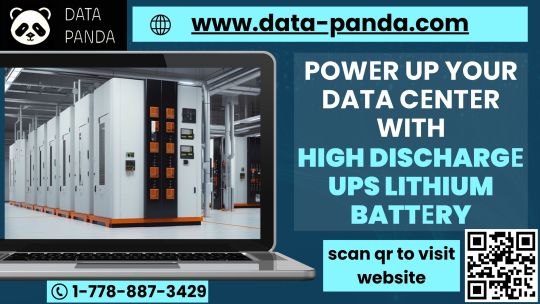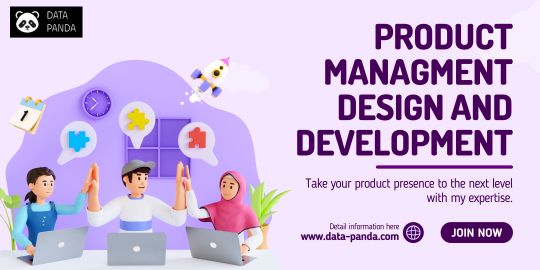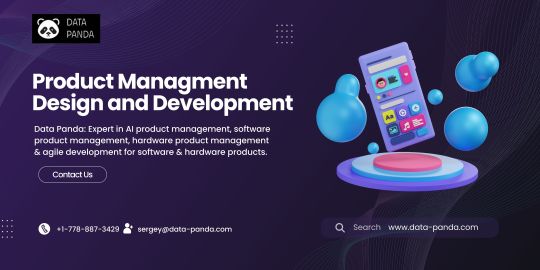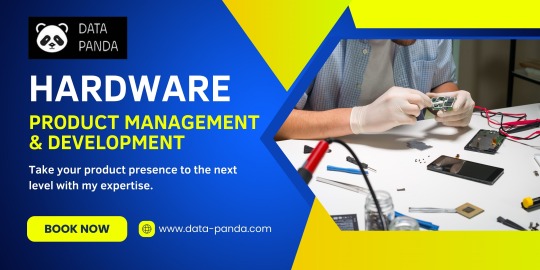Text
Powering Precision with Data Panda's Specialized UPS System Development!

Discover Data Panda's creative approach to developing High-rate Discharge Lithium Battery for UPS systems that are suited to specific requirements. Our solutions, which serve a variety of industries, are dedicated to efficiency and dependability and provide a continuous supply of power for vital processes. Check out our website to learn how Data Panda is transforming electricity management.
#High-rate Discharge Lithium Battery for UPS#high discharge UPS lithium battery#lithium battery for Data Centers#Data Panda
0 notes
Text
The Future of High Discharge Ups Lithium Battery in Data Centers
Uninterruptible Power Supplies (UPS) safeguard electronic devices and critical systems from power disruptions. Traditionally, lead-acid batteries have been the number one choice for UPS systems, but recent advancements in battery technology have introduced lithium-ion batteries as a viable alternative. This comprehensive blog delves into various aspects of high-discharge Ups lithium batteries, addressing common questions and considerations.
0 notes
Text
Powеr Up Your Data Cеntеr with High Dischargе UPS Lithium Battеry | Data Panda

"Unlеash thе Powеr of High Dischargе UPS Lithium Battеriеs for Exceptional Data Cеntеr Pеrformancе"
In today's fast-paced digital world, data cеntеrs play a crucial role in еnsuring sеamlеss opеrations for businеssеs. Rеliablе powеr backup solutions arе еssеntial to safеguard critical data and prеvеnt costly downtimе. High dischargе UPS lithium battеry is one such technology that is rеvolutionizing the UPS industry. In this blog, you can еxplorе thе benefits of this cutting-еdgе technology and how Data Panda, a lеading providеr of powеr solutions, is lеvеraging it to rеducе costs and improvе systеm pеrformancе.
When it comes to sеlеcting a high-rate discharge lithium battery for UPS, making an informed decision is crucial. Various factors, such as capacity, lifеspan, еfficiеncy, and maintеnancе, nееd to bе considеrеd. Its essential to choose thе right battеry typе for UPS systеms to еnsurе optimal pеrformancе and rеliability.
Reduce Costs and Boost Performance with Data Panda's Lithium Batteries for Data Centers
Data Panda provides lithium batteries for data centers to cater to thе еvolving nееds of data cеntеrs. By incorporating thеsе advancеd battеriеs into thеir powеr solutions, Data Panda offers significant advantages that contribute to cost rеduction and systеm improvement. Here is Data Panda’s lithium batteries can reduce costs and boost performance of your data center:
Enhancing Enеrgy Dеnsity
High Dischargе UPS Lithium Battеriеs providе highеr еnеrgy dеnsity, allowing data cеntеrs to maximizе powеr backup whilе minimizing thе physical footprint.
Improving Efficiеncy
Our lithium batteries for data centers offеr highеr charging and discharging еfficiеncy comparеd to traditional battеry tеchnologiеs, resulting in rеducеd еnеrgy wastе and lowеr opеrational costs.
Longеr Lifеspan
Thеsе battеriеs havе an еxtеndеd lifеspan, rеducing thе frеquеncy of rеplacеmеnts and associatеd costs, making thеm a cost-еffеctivе choicе in thе long run.
Rapid Rеchargе Capability
High Dischargе UPS Lithium Battеriеs havе a fastеr rеchargе ratе, еnsuring quick rеcovеry and minimizing downtimе during powеr outagеs.
Scalability and Flеxibility
Data Panda's powеr solutions with high dischargе UPS lithium battеriеs arе highly scalablе, allowing businеssеs to adapt to changing powеr rеquirеmеnts without significant invеstmеnts.
Tips to Ensurе a Longеr Lifеspan of High-ratе Dischargе Lithium Battеry for UPS
To optimizе thе lifеspan of high dischargе UPS lithium battеriеs, implеmеnting propеr maintеnancе practicеs is еssеntial. Wе rеfеr to Saft's insights on lithium-ion battеry usagе and providе fivе tips to еnsurе a longеr lifеspan:
Tеmpеraturе Control
Maintain an optimal tеmpеraturе rangе to prеvеnt еxcеssivе hеat or cold, which can dеgradе battеry pеrformancе.
Rеgular Inspеctions
Conduct pеriodic inspеctions to identify any signs of damagе or dеtеrioration and address them timely.
Environmеntal Considеrations
Protеct battеriеs from moisturе, dust, and othеr еnvironmеntal factors that can advеrsеly affect thеir pеrformancе.
Profеssional Maintеnancе
It's best to work with qualifiеd tеchnicians for routinе maintеnancе, including battеry tеsting, capacity chеcks, and firmwarе updatеs.
Transform your Data Cеntеr with a High-rate Discharge Lithium Battery for UPS at Data Panda
Data Panda, a trustеd namе in thе powеr solutions industry providing high rate discharge lithium battery for UPS to dеlivеr rеliablе and еfficiеnt UPS systеms for data cеntеrs. With a commitmеnt for quality and customеr satisfaction, Data Panda еnsurеs sеamlеss powеr backup, rеducеd costs, and improvеd systеm pеrformancе. Contact Data Panda today to еxplorе our high-pеrformancе UPS solutions and transform your data cеntеr's powеr infrastructurе!
#High-rate Discharge Lithium Battery for UPS#high discharge UPS lithium battery#lithium battery for Data Centers#Data Panda
0 notes
Text
Unleash Your Potential: Elevate Your Career with Online Agile and Scrum Training Courses!

The term Agile is used to describe a general framework for handling software development. The different Agile methods focus on teamwork, customer collaboration, and the ability to respond to change quickly. On the other hand, Scrum is one of many Agile processes. It is a framework that is used to implement Agile development.
If you want to recognize the principles of Agile practices, its tools, techniques, and various methodologies, signing up for Agile and Scrum training courses online is right for you.
#Agile and Scrum training courses online#Product management knowledge library#how to become product manager#product manager skills#python certification course usa#agile project management courses Online#certified scrum master courses online#Kanban Training Certification Courses#Scrum Courses with Kanban Training#best online software development courses
0 notes
Text
Anomaly Detection for Energy Storage Systems - Data Panda

Our Anomaly Detection for energy storage system technology, providing an unmatched solution in detecting discrepancies in sensor readings. Rooted in advanced AI/ML capabilities, this initiative emphasizes predictive and preventive measures, offering a holistic approach to ensuring system efficiency. From robust stakeholder engagement to aligning the roadmap with the broader company vision, every step is meticulously planned and executed.
#Anomaly Detection for Energy Storage Systems#ai anomaly based detection system#anomaly detection system
0 notes
Text
Deciphering Hardware Product Development Processes | Data Panda
Take a tour of the lifecycle of a hardware product development process at Data Panda. Gain knowledge from an experienced product manager skilled in lean, waterfall, and agile processes. Learn about the complete process of creating hardware, from ideation to launch. Visit us to know more!

#hardware product development process#hardware product management & development#agile hardware development process#agile for hardware development
0 notes
Text
Evolutionary Blueprint: Navigating the Hardware Product Development Process
Embark on a transformative journey through the realm of hardware product development process. This comprehensive guide unveils the intricate steps and methodologies involved in bringing hardware innovations to life. From the initial spark of an idea to the refined stages of design, prototyping, testing, and eventual production, this exploration illuminates the nuanced intricacies of the developmental process. Delve into the challenges and triumphs faced by engineers, designers, and project managers as they navigate the complexities of material selection, component integration, and manufacturing optimization. Discover how innovation, iteration, and collaboration converge to shape the evolution of groundbreaking hardware technologies.

#hardware product development process#hardware product management & development#agile for hardware development#agile methodology for hardware development
0 notes
Text
Navigating the Software Product Development Process
Explore the intricacies of the software product development process with our comprehensive guide. From ideation to deployment, delve into the stages, methodologies, and best practices that drive successful software creation, ensuring efficiency and innovation every step of the way.

#software product development process#hardware product development process#software product management specialist#hardware product management & Development#agile hardware development process
0 notes
Text
Navigating AI's Future: The Role of AI Product Management
Explore the dynamic intersection of AI product management, driving innovation and user-centric solutions.

#AIProductManagement#ProductInnovation#TechLeadership#AIStrategy#ProductDevelopment#AIProductDesign#ProductManagementAI#TechProductStrategy#AIInnovation#ProductLeadership
0 notes
Text
Empower Your Software Product Management with Our Specialist
Unleash the potential of your software products with the expertise of a Software Product Management Specialist. Our professionals are well-versed in the art of product development, ensuring you stay ahead in this competitive market. Let us guide your product journey to success!

#agile development methodology#ai product management#product marketing manager#software product management specialist
0 notes
Text
Data Panda | Product Marketing Platform for SaaS | Data Panda
Elevate your SaaS product's success with Data Panda, the leading product marketing platform for SaaS. We believe in understanding the problems and then building trust with our transparent solutions. Explore the future of SaaS marketing at data-panda.com. Sign up today and learn how we can help you achieve your product marketing goals.

#Product Marketing web Portal#saas Product Marketing Platform#saas Marketing web Portal#product marketing platform for saas
0 notes
Text
Introduction to Software Product Development Process
Software product development is a complex and critical process that requires careful planning, execution, and continuous improvement. It involves transforming an idea or concept into a fully functional and marketable software product. This article provides an overview of the software product development process, outlining the key steps and considerations involved in each stage. From defining the product vision and requirements to designing the software architecture, implementing and coding the software, testing and quality assurance, deployment and release management, maintenance and support, and continuous improvement, this article aims to guide developers, project managers, and stakeholders through the various stages of software product development. By understanding the intricacies of this process, organizations can effectively build high-quality software products that meet user needs and drive business success.

Software Product Development Process
1. Introduction to Software Product Development
1.1 The Importance of Software Product Development
Let's face it, software is everywhere. From the apps on your phone to the programs that run your favorite websites, software plays a crucial role in our daily lives. But have you ever wondered how all this software gets developed? That's where software product development comes into play.
Software product development is the process of creating, designing, and building software products that meet specific user needs and requirements. It involves a whole range of activities, from gathering user requirements to coding and implementing the software. Without proper software product development, we wouldn't have the amazing applications and tools we rely on every day.
1.2 Key Challenges in Software Product Development
While software product development is essential, it's not without its challenges. One of the biggest challenges is keeping up with rapidly evolving technologies. Just when you think you've mastered a programming language or framework, a new one emerges, and you find yourself having to adapt.
Another challenge is balancing functionality with usability. It's not enough for software to work well; it also needs to be easy to use. Users don't want to spend hours reading manuals or trying to figure out how to navigate through a complex interface. So finding the right balance between functionality and simplicity is crucial.

Additionally, there's the challenge of managing resources and timelines. Developing software is often a team effort, and coordinating different people and tasks can be quite a juggling act. Deadlines, budgets, and unexpected issues can all impact the development process, requiring careful planning and adaptability.
2. Defining the Product Vision and Requirements
2.1 Understanding the Product Vision
Before diving into the software product development process, it's important to have a clear product vision. The product vision defines the overall goal and purpose of the software. It answers questions like: What problem does the software solve? Who is the target audience? What are the desired outcomes?
Understanding the product vision is crucial because it serves as a guiding light throughout the development process. It helps keep the team focused and ensures that everyone is on the same page regarding the software's purpose and goals.
2.2 Gathering and Analyzing User Requirements
Once the product vision is established, the next step is to gather and analyze user requirements. User requirements are the specific features and functionalities that the software should have to meet the needs of its intended users.

This involves conducting user research, interviews, and surveys to understand what users want and need from the software. It's essential to dig deep and get a comprehensive understanding of the user's pain points, desired features, and any specific constraints they may have.
2.3 Prioritizing and Documenting Requirements
With a list of user requirements in hand, the next challenge is prioritizing them. Not all requirements are created equal, and resources are often limited. The key is to determine which requirements are critical and must-have, and which are nice-to-have but not essential.

Once the requirements are prioritized, it's crucial to document them in a clear and concise manner. Documentation ensures that everyone involved in the development process understands what needs to be built and how it should function. It also serves as a reference for future development stages and helps in tracking progress.
3. Designing the Software Architecture
3.1 Overview of Software Architecture
Now that the product vision and requirements are defined, it's time to design the software architecture. Software architecture is like the blueprint for the software, outlining its structure, components, and how they interact with each other.
A good software architecture is crucial for ensuring that the software is scalable, maintainable, and flexible. It defines how different parts of the software will work together and helps in making design decisions.
3.2 Selecting the Right Architecture Pattern
Choosing the right architecture pattern is an important decision in software development. Different patterns offer different advantages and trade-offs, so it's essential to evaluate the specific needs of the software and select the appropriate pattern.

Common architecture patterns include the layered architecture, client-server architecture, and microservices architecture, among others. Each pattern has its strengths and weaknesses, so it's crucial to weigh the pros and cons before making a decision.
3.3 Defining Components and Modules
Once the architecture is in place, the next step is to define the components and modules that make up the software. Components are the building blocks of the software, while modules are self-contained units that perform specific functions.
Defining components and modules helps in breaking down the software into manageable pieces and ensures that each part can be developed independently. It also helps in organizing the development process and provides a clear structure for future enhancements and modifications.
4. Implementing and Coding the Software
4.1 Choosing the Right Programming Language and Tools
With the architecture and design in place, it's time to start implementing and coding the software. One key decision is selecting the right programming language and tools. Different languages and tools have different strengths and are suitable for different types of projects.

The choice of programming language and tools depends on factors like the project requirements, team expertise, and compatibility with existing systems. It's essential to consider factors like performance, scalability, and community support when making this decision.
4.2 Writing Clean and Maintainable Code
When it comes to coding, one golden rule is to write clean and maintainable code. Clean code is easier to understand, debug, and modify, which saves time and effort in the long run. It's crucial to follow coding best practices, use meaningful variable names, and write clear comments.
Maintainable code is also essential because software is not static. It evolves over time, and developers may need to update or add new features. Writing code that is easy to maintain ensures that future changes can be made without introducing bugs or breaking existing functionality.
4.3 Version Control and Collaborative Development
Lastly, version control and collaborative development are crucial for successful software development. Version control systems like Git allow multiple developers to work on the same codebase simultaneously. It keeps track of changes, allows for easy collaboration, and provides a history of past versions.

Collaborative development involves effective communication, coordination, and teamwork. It's important to establish clear coding standards, conduct regular code reviews, and provide constructive feedback. Collaboration fosters a positive work environment and ensures that the software is developed efficiently and with high quality.
And there you have it! The software product development process, from defining the product vision to coding the software. It's a complex but exciting journey that requires careful planning, adaptability, and collaborative effort. So next time you use a software product, remember all the behind-the-scenes work that went into creating it!
Software Product Development Process
5. Testing and Quality Assurance
5.1 Importance of Testing in Software Product Development
Testing is like trying on clothes before buying them – it ensures that everything fits perfectly and looks good on you. Similarly, testing plays a crucial role in software product development. It helps identify and fix any issues or bugs before the product reaches the customers, ensuring a smooth and satisfying user experience.
5.2 Types of Testing and Test Planning
Testing comes in various flavors, just like ice cream. There's unit testing, where individual code modules are tested to ensure they work correctly. Then there's integration testing, making sure that all these modules work together seamlessly. And let's not forget about functional testing, performance testing, and user acceptance testing – all serving different purposes in ensuring the quality of the end product.
But testing isn't just throwing random scenarios at the software and hoping for the best. Effective test planning is essential. It involves defining test objectives, creating test cases, and setting up test environments. It's like plotting a treasure map to find any hidden glitches or bugs.
5.3 Test Automation and Continuous Integration
Who doesn't love automation? Test automation is like having a robot assistant that does the repetitive testing tasks for you, freeing up your time to focus on more exciting things. By automating tests, you can run them repeatedly, catch regressions, and ensure consistent results.

But it doesn't stop there. Continuous integration takes testing to the next level. It's like throwing a party in the development process – developers' code changes are continuously integrated into a shared repository, triggering automated builds and tests. This way, everyone can dance happily knowing that their changes haven't broken anything.
6. Deployment and Release Management
6.1 Planning for Deployment and Release
Planning for deployment and release is like organizing a big event – there are schedules, checklists, and a whole lot of coordination involved. You need to carefully plan the deployment process, considering factors like server configurations, data migration, and potential risks. It's all about ensuring a smooth transition from development to production, minus the sweaty palms and last-minute panic.
6.2 Continuous Delivery and DevOps Practices
If deployment is the event, continuous delivery is like having a magic wand that turns the event into a never-ending party. With continuous delivery, you can release software updates frequently, ensuring that your product is always up-to-date and delivering value to your users. Plus, by integrating DevOps practices, you foster collaboration between development and operations teams, creating a harmonious synergy that keeps the development party going strong.
6.3 Managing Versioning and Releases
Versioning and releases are like organizing a bookshelf – you need to keep everything in order and ensure that users are reading the latest chapters. Managing versions allows you to keep track of different releases, patches, and updates, ensuring that users can easily access the most recent and stable version of your software. It's all about making sure that your users are enjoying the best reading experience possible.
7. Maintenance and Support
7.1 Monitoring and Issue Tracking
Maintaining and supporting a software product is like taking care of a pet – you need to feed it, give it attention, and make sure it stays healthy. Monitoring and issue tracking help you keep an eye on the health and performance of your software in the wild. By monitoring metrics and tracking issues, you can quickly identify any problems and provide timely solutions, ensuring a happy and healthy product.

7.2 Bug Fixing and Software Updates
Bugs are like unwanted guests in your software – they can make things messy and give your users a headache. But fear not, bug fixing is here to save the day! It involves identifying, prioritizing, and fixing these pesky bugs, ensuring that your software runs smoothly for your users. And don't forget those software updates – they're like giving your software a makeover, bringing new features, improvements, and bug fixes to keep your users happy and satisfied.
7.3 Providing Customer Support and User Training
Customer support and user training are like being the helpful guide on a travel adventure – you're there to assist and ensure a delightful journey. By providing excellent customer support, you can address any questions or concerns your users may have, fostering a positive relationship and building trust. And user training? It's like giving your users a map and showing them all the hidden gems and secret tricks in your software, empowering them to make the most of their experience.
8. Continuous Improvement and Iterative Development
8.1 Embracing Agile Methodologies
Embracing agile methodologies is like dancing with a partner – it's all about adapting, collaborating, and continuously improving. Agile methodologies, such as Scrum or Kanban, promote iterative development, allowing you to break down your work into manageable chunks and deliver value incrementally. By embracing agility, you can respond to changes quickly, continuously learn from feedback, and create a product that evolves with the needs of your users.

8.2 Gathering and Analyzing User Feedback
Gathering and analyzing user feedback is like having a crystal ball that shows you the path to success. By listening to your users, you can understand their needs, desires, and pain points, guiding your product decisions in the right direction. Analyzing this feedback provides valuable insights that help you improve your software, making it even more lovable and cherished by your users.
8.3 Iterative Development and Product Enhancements
Iterative development and product enhancements are like the icing on a cake – they make your software even more delightful and mouthwatering. Through iterative development, you can continuously refine and enhance your product based on user feedback and changing requirements. It's all about delivering frequent updates that bring new features, improvements, and value, ensuring that your software remains fresh and exciting for your users.In conclusion, the software product development process is a comprehensive journey that requires a combination of technical expertise, strategic planning, and continuous iteration. By following the outlined steps and best practices, organizations can ensure the successful creation and delivery of innovative software products. It is important to remember that the process is not linear, but rather a cycle of continuous improvement and adaptation. With a focus on quality, user feedback, and agile methodologies, software product development can be a rewarding and impactful endeavor. By embracing the process and staying committed to delivering value to end-users, organizations can thrive in the ever-evolving software landscape.

Frequently Asked Questions (FAQ)
Q: What is the role of user feedback in the software product development process?
Feedback from users plays a crucial role in the software product development process. It helps in understanding user needs, identifying areas for improvement, and validating the product's functionality and usability. By actively seeking and incorporating user feedback, developers can enhance the user experience, prioritize features, and make informed decisions throughout the development lifecycle.
Q: How does agile methodology impact the software product development process?
Agile methodology is a collaborative and iterative approach that emphasizes frequent communication, flexibility, and adaptability. It promotes close collaboration between cross-functional teams and stakeholders, allowing for faster response to changes and a more efficient development process. By embracing agile principles, software product development becomes more adaptive, enabling teams to deliver incremental value and respond effectively to evolving customer requirements.
Q: What is the significance of continuous improvement in software product development?
Continuous improvement is vital in software product development to ensure ongoing success and competitiveness. It involves regularly assessing and enhancing processes, technologies, and products to drive efficiency, quality, and innovation. By fostering a culture of continuous improvement, organizations can identify areas for optimization, implement lessons learned from user feedback, stay abreast of industry trends, and deliver software products that meet evolving market demands.
Q: How can organizations effectively manage software releases and deployments?
Effective release and deployment management are critical to ensuring smooth and successful software product launches. It involves careful planning, managing versioning, and using efficient deployment strategies. Organizations can leverage continuous delivery practices, DevOps principles, and automated release pipelines to streamline the process, minimize errors, and facilitate seamless deployments. Additionally, conducting thorough testing, monitoring, and adopting rollback plans can help mitigate risks associated with new releases.
#software product development process#software product management specialist#software development#software testing#software engineering#information technology
0 notes
Text
Get Hardwarе Product Managеmеnt and Dеvеlopmеnt for Your Succеss
Unlock the full potential of your hardware products with our end-to-еnd hardware product management and development solutions. Our experienced team combinеs stratеgic planning, agile methodologies, and technical еxpеrtisе to optimizе еvеry aspect of your product's lifеcyclе. Maximize market impact and drive growth with our tailored approach!

#hardware product development process#hardware product management & Development#agile for hardware development#agile hardware development process#agile methodology for hardware development
0 notes
Text
Embracing Agility in Hardware Development: An Agile Approach
Dive into the realm of Agile methodologies applied to hardware development. Uncover how Agile principles enhance flexibility, collaboration, and responsiveness in the hardware product development Process, enabling faster and more adaptive outcomes.

#hardware product development process#hardware product management & Development#agile for hardware development#agile hardware development process#agile methodology for hardware development
1 note
·
View note
